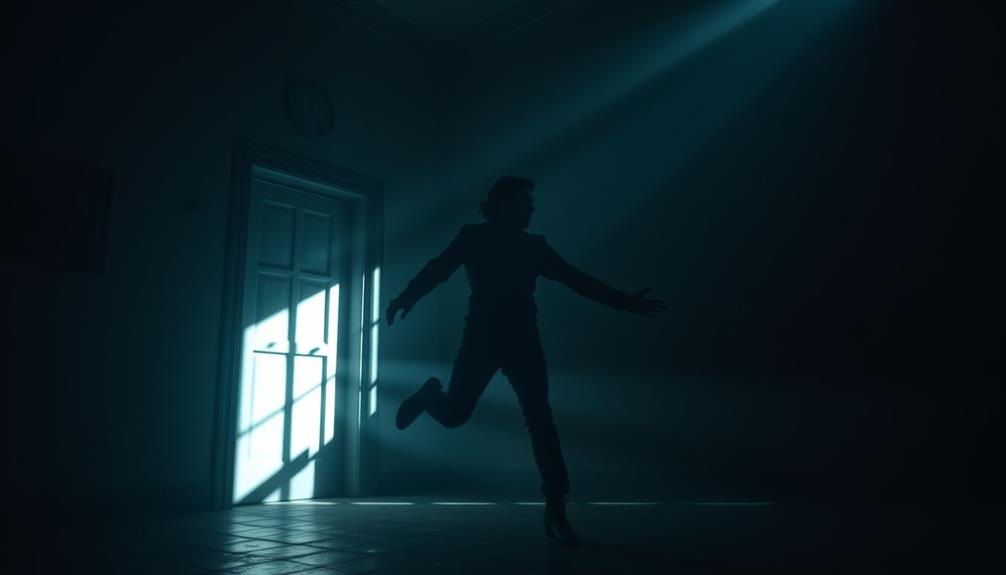Freezing episodes in Parkinson's disease can leave you feeling stuck, impacting daily activities and mobility. About 38% of individuals experience these episodes, often triggered by shifting from standing to walking or maneuvering tight spaces. These sudden stops increase the risk of falls and can lead to stress and anxiety. To manage these challenges, it is vital to consult healthcare professionals for tailored strategies. Techniques like auditory or visual cues, weight shifting, and mindfulness can help. Understanding the role of support from family and healthcare providers is significant, and there's much more you can explore to enhance your coping strategies.
Key Takeaways
- Freezing of gait (FOG) is a common symptom in Parkinson's Disease, affecting approximately 38% of individuals annually.
- Common triggers for freezing episodes include transitioning from standing to walking, navigating doorways, and engaging in conversation while walking.
- Effective management includes medication adjustments, mindfulness practices, and developing support networks to address triggers and enhance coping strategies.
- Techniques such as auditory and visual cues, weight shifting, and the 4 S Strategy can help individuals regain mobility during freezing episodes.
- Professional support from neurologists, therapists, and support groups is essential for personalized care and improving overall quality of life.
What Is Freezing?

Freezing of gait (FOG) is a common phenomenon in Parkinson's Disease, where you might suddenly find yourself unable to move, as if your feet are glued to the ground. This temporary and involuntary inability to move, often experienced during shifts like standing to walking, can be quite distressing.
Approximately 38% of individuals with Parkinson's experience freezing episodes annually, and these episodes tend to increase as the disease progresses. Individuals with other conditions, such as Borderline Personality Disorder, may also experience emotional dysregulation, which can complicate their overall management and coping strategies.
These freezing moments can last from a few seconds to several minutes, leaving you feeling stuck or trapped. They can be triggered by various environmental factors, such as tight spaces or changes in the floor surface, as well as by stress or cognitive overload.
Recognizing these episodes is vital for effective management. Many people notice that freezing tends to occur when they're "off" their dopaminergic medication, highlighting the importance of medication timing in your daily routine.
Understanding the experience of freezing can help you and your caregivers better prepare for these episodes, ensuring that you have strategies in place to minimize their impact on your life.
With proper management, you can navigate the challenges that come with FOG more effectively.
Common Triggers

Many people with Parkinson's find that certain situations can trigger freezing episodes, making it important to identify these common triggers. By recognizing these scenarios, you can better prepare and manage your symptoms.
| Trigger | Description |
|---|---|
| Standing to Walking | About 38% of individuals report freezing during this shift. |
| Maneuvering Doorways | Often causes a feeling of being momentarily stuck. |
| Turning Corners | Changing directions can lead to freezing episodes, increasing the risk of falls. |
| Stepping Between Surfaces | Moving from surfaces like carpet to tile can trigger freezing. |
| Stress and Multitasking | Engaging in conversation while walking can exacerbate freezing incidents. |
Being aware of these triggers can help you take proactive steps to minimize their impact. For example, practicing mindfulness techniques to reduce stress or planning your walking routes to avoid tricky corners can be beneficial. Remember, you're not alone in this experience, and understanding these common triggers is the first step towards managing freezing episodes effectively.
Impact on Mobility

Freezing episodes can really limit your mobility, making it tough to move around your own home.
These episodes may be exacerbated by factors such as fatigue and stress, which can further complicate daily activities.
This increased difficulty can contribute to a higher risk of falls, which is a significant concern for many with Parkinson's.
Understanding how these episodes affect your movement is essential for finding ways to improve your mobility and safety, especially when considering the importance of selecting the right cold medication for effective relief.
Mobility Limitations
For about 38% of individuals with Parkinson's, mobility becomes a daily struggle due to episodes of freezing. These freezing episodes can severely limit your ability to move, making it difficult to engage in daily activities and navigate your environment. You might find that changes, like moving from sitting to standing or changing direction, often trigger these episodes, leading to increased anxiety and fear of falling.
Understanding the significance of financial planning for assisted living can also be beneficial as mobility limitations may necessitate future care needs.
As a result, you may become hesitant to participate in activities outside your home, which can impact your quality of life. The unpredictability of freezing episodes can erode your confidence, making you less willing to move freely. This can restrict mobility within your home, limiting opportunities for socialization and community engagement.
Decreased social interaction can further exacerbate feelings of isolation, creating a cycle that affects both your mental and physical well-being. It's crucial to recognize how these mobility limitations influence your overall experience with Parkinson's disease.
Fall Risk Increase
As you maneuver through daily life with Parkinson's disease, the risk of falling can become a pressing concern, especially during freezing episodes. Approximately 38% of individuals with Parkinson's experience falls annually, with many linked to these unpredictable moments that often occur when turning or changing directions.
Incorporating strategies from mastering the art of bug out bags can help in preparing for emergencies that may arise due to these episodes. The sudden loss of movement during freezing episodes can severely impact your mobility and increase your fall risk, particularly in narrow spaces or when maneuvering around obstacles.
When you encounter these challenges, your balance may be compromised, making it difficult to regain stability. Attempting to assist someone experiencing freezing can inadvertently lead to a loss of balance, heightening the risk of falls.
This unpredictability not only disrupts your daily activities but can also restrict social interactions and diminish your overall quality of life.
To minimize the risk, it's essential to develop strategies for managing freezing episodes and to inform those around you about the challenges you face. By doing so, you can enhance your safety and confidence, allowing you to maneuver through your environment more effectively and maintain a greater sense of independence.
Risks of Falling

Steering through life with Parkinson's can feel like walking a tightrope, especially when it comes to the risks of falling. Approximately 38% of individuals with Parkinson's experience falls annually, and freezing episodes notably contribute to this risk. These episodes often occur when you attempt to turn or change direction, heightening the unpredictability of your movements.
Understanding the importance of key domains of development can also shed light on how emotional factors influence movement and decision-making in individuals with Parkinson's. This unpredictability can create a heightened fear of falling, which can limit your mobility and social engagement. The stress of anticipating a fall might make you hesitant to move, leading to a cycle that further diminishes your quality of life.
Additionally, when someone offers assistance during a freezing episode, it can inadvertently cause you to lose balance, increasing the likelihood of falls.
Injuries sustained from falls can be severe, leaving lasting impacts on your daily activities and independence. Understanding these risks is essential, as it empowers you to manage your environment and seek solutions that enhance your safety.
Managing Freezing Episodes

Managing freezing episodes in Parkinson's disease requires a proactive approach that combines medical guidance and practical strategies. Start by consulting with your healthcare professional to develop tailored strategies that address your specific needs. Adjustments to your dopaminergic medications might help reduce the frequency and intensity of freezing episodes, particularly during "off" periods.
Additionally, adopting a mindset that encourages creativity in problem-solving can be beneficial; for instance, exploring enhanced user experience strategies may inspire new ways to cope with challenges.
Incorporating physical therapy into your routine can enhance muscle strength, balance, and posture, ultimately decreasing the likelihood of freezing. A physical therapist can design personalized exercises that directly target these areas.
Utilizing external cues can also be beneficial. Consider using auditory signals, like rhythmic counting, or visual markers, such as lines on the floor, to help initiate movement during freezing episodes. These cues can serve as helpful reminders for your brain to trigger movement.
Additionally, occupational therapy can play a significant role in managing freezing episodes. An occupational therapist can help modify your home environment to minimize triggers and improve safety, ensuring you have a supportive space that reduces the risk of falling.
Techniques to Overcome Freezing

Building on the strategies for managing freezing episodes, several effective techniques can help you overcome these challenging moments. One method involves using auditory cues, like rhythmic counting or music, to synchronize your movement and initiate walking.
You can also incorporate visual cues, such as stepping over a line or directing a laser pointer on the ground, which can help direct your attention to the next step. Additionally, consider utilizing essential oils like eucalyptus oil for its decongestant effects, which may aid in calming anxiety that sometimes accompanies freezing episodes.
Another valuable technique is shifting your body weight side to side before stepping. This simple action can help you regain mobility and break the sensation of being stuck.
The 4 S strategy—STOP, SIGH, SHIFT, STEP—can also assist you in regaining control during a freezing episode. By taking a moment to pause and breathe, you create a mental space to shift your focus and encourage movement.
Engaging in high-stepping or marching in place can further help you break the freezing cycle and promote movement initiation. By practicing these techniques, you can enhance your confidence in managing freezing episodes and improve your overall mobility.
Role of Family and Friends

When you're supporting someone with Parkinson's, your calm presence during freezing episodes can make a big difference.
Understanding the importance of philosophical exploration can deepen your empathy and improve your support strategies.
Encouraging them to use movement techniques, like stepping over an object, can help them regain their mobility.
Maintaining Calm During Episodes
Supporting a loved one during a freezing episode requires a calm and patient approach. When they experience freezing episodes, your calmness is crucial, as stress can worsen the situation and make it harder for them to regain movement.
It's important to wait patiently and avoid rushing or pushing them, as this can lead to loss of balance and potential falls. Incorporating techniques from practices like yoga, such as gentle stretching or breathing exercises, can also help them manage their body's tension during these moments, promoting relaxation yoga for back pain.
Encouraging them to take small steps can be beneficial. You might suggest stepping over a foot placed perpendicularly, which can help them re-initiate movement effectively. Techniques like marching in place, counting, or gentle rocking can also facilitate movement during these challenging moments.
Additionally, you can provide valuable support by utilizing visual cues, such as targets on the ground, to guide their steps. Auditory cues, like playing music, can also help stimulate movement.
Encouraging Movement Techniques
Family and friends often play an essential role in helping someone with Parkinson's Disease navigate freezing episodes. You can encourage movement by using various techniques that promote mobility and balance. Maintaining a calm demeanor is vital, as stress can worsen the situation. Here are some effective strategies:
| Technique | Description |
|---|---|
| Step Over Objects | Place an object perpendicularly to encourage the individual to step over it, providing a physical cue to initiate movement. |
| Rhythmic Activities | Encourage activities like marching or counting to engage cognitive focus and facilitate movement. |
| Visual Cues | Use markings on the floor or a laser pointer to create stepping cues, helping regain mobility. |
| Gentle Rocking | Offer gentle rocking motions or side-to-side weight shifts to promote balance and movement. |
| Positive Reinforcement | Always provide encouragement and positive feedback to boost confidence during episodes. |
Professional Support Options

How can professional support enhance your management of freezing episodes in Parkinson's Disease? Engaging with a team of healthcare professionals can greatly improve your ability to cope with these challenges. As technology advances, the integration of AI training jobs entry level may provide new tools that assist in monitoring and managing symptoms effectively. Here's how:
- Neurologists: Regular consultations can help adjust your medication regimens, alleviating symptoms during those frustrating "off" periods.
- Physical and Occupational Therapists: These specialists create tailored exercise programs that enhance mobility, reduce fall risks, and suggest modifications to your environment to make daily activities easier.
- Support Groups: Participating in groups led by healthcare professionals can bolster your emotional well-being by providing a platform for shared experiences and coping strategies, helping you feel less isolated.
A multidisciplinary care approach, involving neurologists, physical therapists, and occupational therapists, is essential for effectively managing freezing episodes and monitoring symptom progression.
Regular follow-ups with your healthcare providers guarantee that your treatment plan remains responsive to your evolving needs.
Innovative Research Approaches

As you explore innovative research approaches, you'll see how technology is transforming the treatment of freezing episodes in Parkinson's disease.
Wearable devices and mobile apps are being developed to provide real-time monitoring, while holistic management techniques, like mindfulness, emphasize mental well-being.
Together, these strategies aim to enhance the quality of life for those affected by this challenging condition.
Technology in Treatment
What if technology could transform the way you manage freezing episodes in Parkinson's disease? Innovative research approaches are paving the way for exciting developments in treatment that could enhance your quality of life.
Here are three key technologies making waves:
- Wearable Devices: Equipped with sensors, these devices monitor your movement patterns and can even predict freezing episodes, allowing for timely interventions.
- Mobile Applications: Designed to provide real-time feedback, these apps offer personalized interventions that help manage freezing of gait symptoms effectively.
- Virtual Reality: This technology engages you in therapeutic exercises that may greatly improve movement initiation and control, making rehabilitation more interactive and enjoyable.
Additionally, deep brain stimulation is being explored as a potential treatment to alleviate freezing episodes in select patients.
Ongoing clinical trials are also investigating new therapeutic techniques like neuromodulation and cognitive training to reduce the frequency and severity of these episodes.
Holistic Management Techniques
Managing freezing episodes in Parkinson's disease requires a multifaceted approach, and innovative research is now uncovering holistic techniques that can make a real difference. One promising avenue involves the use of virtual reality and gaming technologies as rehabilitation tools, enhancing movement initiation and coordination. These engaging methods can motivate you to practice essential skills while having fun.
Wearable devices and mobile applications are also gaining traction, allowing you to track freezing episodes in real-time. This data can inform personalized management strategies tailored to your unique needs.
Additionally, integrating mindfulness and stress management techniques may help reduce anxiety-related triggers that worsen freezing episodes, promoting a calmer mindset.
Ongoing studies are exploring the effectiveness of deep brain stimulation as a therapeutic option for freezing gait, though it's important to remember that its suitability varies among individuals.
Moreover, collaborative efforts are focused on developing tailored exercise programs designed to enhance your mobility and reduce the frequency of freezing episodes through consistent physical activity.
Resources for Patients

Accessing reliable resources is essential for traversing the challenges of freezing episodes in Parkinson's Disease. These resources can empower you with knowledge, strategies, and support tailored to your needs. Here are three key resources to explore:
- Online Platforms: Websites like Parkinson's UK and the Michael J. Fox Foundation offer articles, webinars, and videos that focus on effective strategies for managing freezing episodes.
- Support Groups: Connecting with others in support groups or community resources can enhance your social connections and provide invaluable coping strategies. Sharing experiences can make a real difference in managing your condition.
- Healthcare Collaborations: Work closely with healthcare providers, including neuro-physiotherapists and occupational therapists. They can help develop personalized care plans that address your unique challenges with freezing episodes and improve your mobility.
Additionally, consider attending local workshops and exercise classes tailored to individuals with Parkinson's.
Access to literature and case studies can further empower you to understand the complexities of freezing episodes, leading to better symptom management and an improved quality of life.
Frequently Asked Questions
What Aggravates Parkinson's Disease?
Stressful situations, multitasking, fatigue, and environmental triggers can all aggravate your Parkinson's symptoms. Additionally, cognitive challenges and medication off periods may worsen motor issues, making it harder for you to manage daily activities effectively.
What Time of Day Are Parkinson's Symptoms Worse?
In the morning, symptoms often spike as medications wear off. Late afternoons can bring increased difficulties too, with fatigue compounding issues. You might feel more pronounced challenges during these times, making management essential.
What Foods Are High in Dopamine for Parkinson's Disease?
To boost dopamine levels, you should include lean proteins like chicken and fish, bananas, leafy greens, nuts, and dark chocolate in your diet. These foods can support your brain health and enhance overall well-being.
What Is a Superfood for Parkinson's Disease?
A superfood for Parkinson's disease is fatty fish like salmon. It's rich in omega-3 fatty acids, which can enhance cognitive function and reduce inflammation, contributing positively to your overall brain health and well-being.
Conclusion
In summary, understanding and managing freezing episodes in Parkinson's disease can feel like traversing a maze. By recognizing triggers and employing effective strategies, you can regain control over your mobility and reduce the risk of falls. Remember, you're not alone in this journey; the support of family, friends, and professionals is essential. As you seek innovative solutions and resources, you'll discover new pathways to improve your quality of life and maintain your independence. Additionally, it’s important to recognize that **vision issues in Parkinson’s disease** can exacerbate freezing episodes, making it even more challenging to navigate everyday environments. Addressing these visual difficulties, alongside motor symptoms, is crucial for comprehensive management and overall well-being. By incorporating adaptive tools and therapies, you can further optimize your ability to engage in daily activities with confidence and ease.









